One of my favorite parts of this job, besides building and maintaining relationships with my chimpanzee friends, is getting to participate in our Positive Reinforcement Training Program. Positive Reinforcement Training (PRT) means we use rewards (food, praise, play, etc) to reinforce and encourage desirable behavior. We do this to provide the chimps and cattle with the ability to participate in their own care, and make necessary tasks (such as preparing for a sedation or even serving of meals) as stress free as possible for everyone involved.
Recently we were discussing the need for Gordo to have a routine physical exam to get a better understanding of his current heart health and health overall. This posed a bit of a daunting task as our goal before completing the exam is to have him comfortable with being separated from his group, and participating in training with a focus on injection training. At the time of the discussion, Gordo had only trained a handful of times and generally did not show interest in participating when we asked him to. Here comes the fun part…making a plan to achieve this goal, tweaking the plan as we encounter obstacles, and most importantly – making the whole experience positive and enjoyable for Gordo and strengthening our relationship along the way!
You may be wondering, why does he need to be comfortable being separated from his group? In order to safely sedate and then remove a sleeping Gordo for his exam, he needs to be alone. This is both for his safety so he is not vulnerable to others as he falls asleep, and for our safety as we then have to enter his room once he is asleep to take him to the clinic for his exam. Through PRT, we can work to make being separated from the group a positive experience (for example, being by himself means he gets a jackpot reward of several of his favorite things) which will help him feel less stressed as we prepare for his exam. Without training him for separation, it would likely cause much more stress for him when being separated as there would not be an existing positive experiences under these circumstances. We also have the goal to focus on injection training so that when the time comes, he will hopefully present his arm or leg for his injection to begin the sedation process. This is less stressful and easier to accomplish than having to use a small dart gun to administer the sedatives.
The first step was to write a shaping plan – a step by step guide for how we hoped to accomplish these goals. Jenna wrote a plan, and we were quick to get to work on it! Only one problem, Gordo was not as eager as we were to start the training. Most of his group is incredibly interested in training, so we had to have two trainers – one to occupy everyone else, and one to train with Gordo. We quickly altered our plan to train with him during meal time, when he often separates himself from the group naturally and comes up readily to receive his meal. We use a frisbee with hooks on the back of it to show him where we would like him to stay during the session (this is called a station marker), and he got the hang of this quickly! He comes up to his station marker, and to my surprise and excitement, he was very interested in training within just one training session!
Gordo stationing (in a box he pulled up to sit in, of course!)
We use both verbal and visual cues to communicate what we are asking of the chimps. For example, if I were to ask Gordo to present his left hand, I would hold up my right hand (mirror image) with my fingers pointed towards him and say “hand.” I would expect him to put his left hand up, sticking all of his fingers (except his thumb…that would be hard to accomplish since it is so small!) through the caging towards me. Gordo was quick to recognize that we were having a training session during the meal, and he started offering up several different behaviors he had learned during his time at Wildlife Waystation and seemed eager to participate. This may sound simple, but for a chimp who just a few weeks before was not interested in coming up to train, this was a big breakthrough and very exciting! As often is the case when working with chimps, we needed to be creative in order to find what worked best for Gordo. We are continuing to work with him on stationing (staying in one place) while doors are being operated, and have been focusing on his arms and legs during training sessions as these are ideal locations for injections. He is doing very well presenting both of his feet, his hands, and his right arm and leg so far! So long as he continues to do well, we will start progressing in his injection training (the next step is simply bringing a capped needle along to our sessions for him to observe), and asking him to move to different locations to station to be sure he understands that the same concept applies in a variety of situations.
Gordo presents his foot
Gordo touches his station marker
Gordo presents his leg and allows for a gentle touch with a chopstick!
PRT is such an amazing tool to have as caregivers. It helps us build stronger relationships of trust and cooperation with those in our care, and also allows them to actively participate in their own care. Through PRT you can get many important diagnostic values that may even prevent a need for sedation and can allow you to monitor existing conditions more regularly. It is incredibly rewarding to make progress in PRT with any trainee, but especially someone like Gordo who was not always interested or motivated to participate in PRT, and who this training can so greatly benefit him by decreasing his stress around a necessary procedure! Go Gordo, go!!!
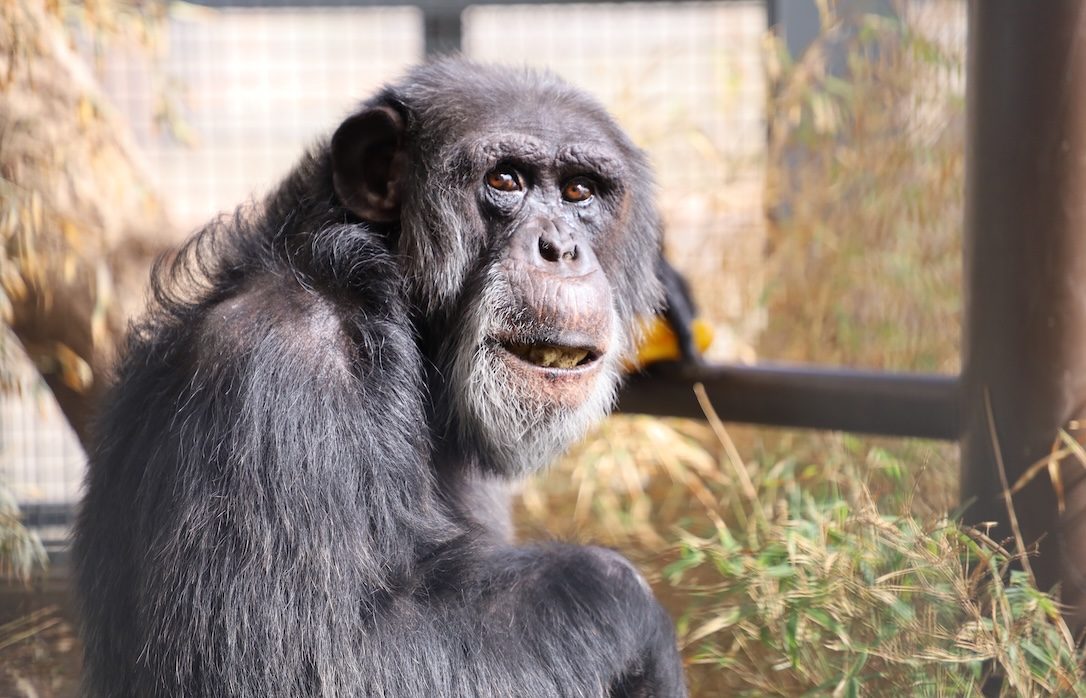
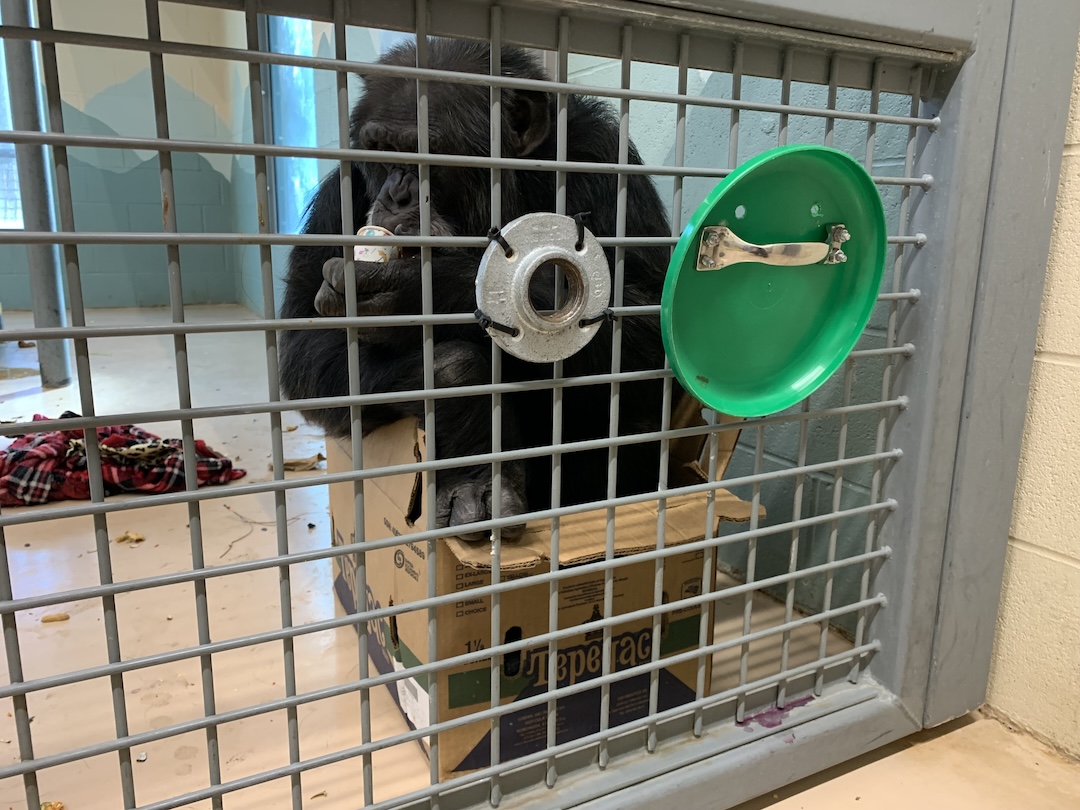
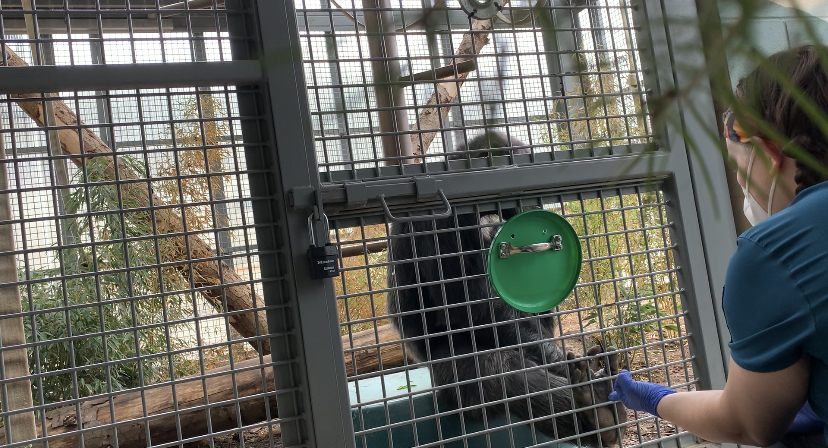
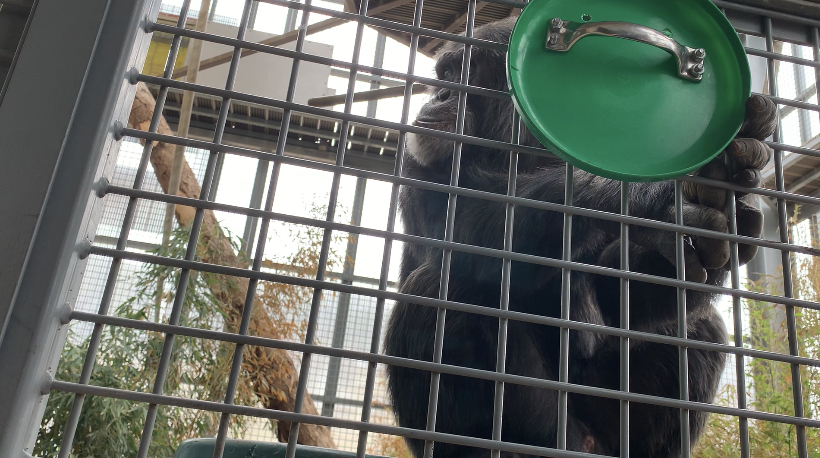
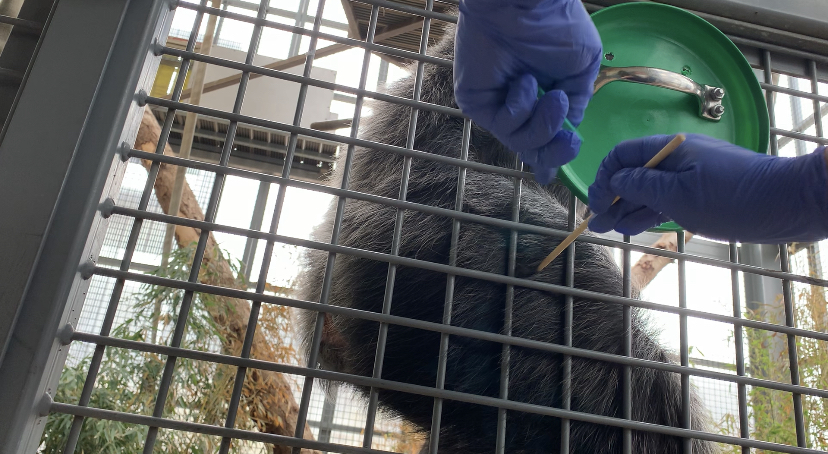




Thank you for explaining this in such detail, Ellen. There have been previous blog posts and video discussions about PRT, but just like the chimps, us humans retain more of the information with repetition. I’m glad Gordo is doing so well this time around, for whatever reason has now motivated him to participate!
I’m glad you found a way to get through to him, Ellen!
(I’d love to be able to tickle those stubby little feet!)
Many thanks, Ellen, for this interesting and informative post and the amazing photos of Gordo (especially the one with the chopstick!) participating in the P R T run through. What would happen in a situation where for some reason the chimp was not fully sedated or suddenly regained consciousness during a procedure or transport to that procedure? Of course you have a fantastic medical team on hand but has such a situation occurred?
Your post reinforced the importance of calming and building trust in these amazing chimpanzees and the huge lengths you all go to ensuring they receive the best treatment. Gordo is doing very well, good on him and good on you!
Ellen, this was a great explanation, and easy to understand. So much goes into training. Every step must be pre- planned and able to change based on the current situation. Everything you all do is so much appreciated!
I agree with the other comments–so fun and interesting to learn more about the PRT process, and how it is a bit different for each chimpanzee based on their personality and life experiences. Thank you for sharing it with us!
Thanks for the great work with Gordo. I remember him well from Wildlife Waystation and it definitely was not so easy to deal with him!!
(But we still loved him, of course!!)
The photo of Gordo in his box at his station (green for GO! Gordo!) is priceless. Congrats on sparking Gordo’s interest in your PRT. What a great feeling it must be to see him willingly participating and learning so quickly. And it sounds like he knows a few moves from WW too! So Gordo is handsome, smart, and a little shy.
Yeah Gordo!!!! I’m glad he’s figured out that PRT is fun!
Of course, he’s gotta have a box to sit in. I swear he’s part cat!
Referring back to Anna’s post from yesterday, I want to add that Gordo has some pretty floofy Shoulder Swoops too! 🙂
Great job Gordito!!! and great job to the caregivers as well! Ive said it before a chimp or any animal that will accept a hand injection for anesthesia is 1000 times less stressful on everyone esp. the one being anesthetized! Makes for a smoother anesthesia as well!